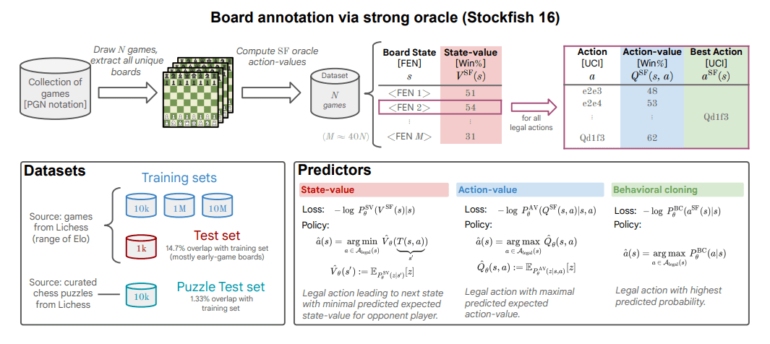TL;DR:
- Google DeepMind’s study showcases a groundbreaking leap in chess AI, utilizing large-scale data and advanced neural architectures.
- They trained a transformer model with 270 million parameters purely through supervised learning on a dataset of 10 million chess games.
- The model moves away from traditional search algorithms, learning directly from chessboard positions.
- Achieving a Lichess blitz Elo rating of 2895, it outperforms AlphaZero and GPT-3.5-turbo-instruct in chess strategy execution.
- The study highlights the importance of scale in AI’s effectiveness and the balance between data diversity and computational heuristics.
Main AI News:
The fusion of artificial intelligence with the timeless game of chess has long fascinated scholars, providing an ideal arena for pushing the boundaries of computational strategy and intellect. From IBM’s historic Deep Blue triumph in 1997 against the reigning world champion to today’s advanced engines like Stockfish and AlphaZero, the journey has been marked by a relentless pursuit of refining machine intelligence. These strides have predominantly relied on explicit search algorithms and complex heuristics tailored to dissect and dominate the chessboard.
In an age where AI’s prowess hinges on its adaptability and learning capabilities, a groundbreaking study from Google DeepMind has reshaped the landscape by leveraging vast amounts of data and sophisticated neural architectures. This research heralds a bold experiment: training a transformer model equipped with a staggering 270 million parameters solely through supervised learning techniques, utilizing an extensive dataset of 10 million chess games. This model distinguishes itself by eschewing traditional domain-specific adaptations and the exhaustive navigation of chess decision trees.
Instead of weaving intricate search paths and crafted heuristics, the model learns to anticipate optimal moves directly from the chessboard’s positions. This methodological shift not only breaks from convention but also showcases the transformative potential of large-scale attention-based learning. By annotating each game state with action values gleaned from the formidable Stockfish 16 engine, the research taps into a deep well of strategic insight, distilling it into a neural network capable of decision-making at a grandmaster level.
The performance metrics of this transformer model are truly revolutionary. Boasting a Lichess blitz Elo rating of 2895, it not only establishes a new pinnacle in human-computer chess matches but also displays exceptional proficiency in unraveling intricate chess puzzles that traditionally stumped even the most advanced search-based engines. A comparative analysis with industry titans further emphasizes this quantum leap in performance. Surpassing not only the policy and value networks of AlphaZero, which itself revolutionized AI’s chess approach through self-play and deep learning, but also eclipsing the capabilities of GPT-3.5-turbo-instruct in comprehending and executing chess strategies.
This groundbreaking success narrative is rooted in a meticulous examination of the factors fueling AI excellence in chess. The study highlights a direct correlation between the scale of training data and the model’s efficacy, showcasing that deep strategic understanding and the capacity to generalize across novel board configurations emerge only at a certain threshold of dataset magnitude and model complexity. This revelation underscores the pivotal role of scale in AI’s conquest of intellectual domains, illustrating the delicate interplay between data diversity and computational heuristics.
Conclusion:
Google DeepMind’s breakthrough in advancing chess AI signifies a paradigm shift in the industry. By harnessing large-scale data and sophisticated neural architectures, they’ve demonstrated the immense potential of machine learning in mastering complex intellectual tasks. This innovation not only sets new benchmarks in human-computer chess interactions but also underscores the crucial role of data scale and model complexity in shaping the future of AI applications in various domains. Businesses in the AI sector must take note of these advancements and invest in similar approaches to stay competitive in a rapidly evolving market.

